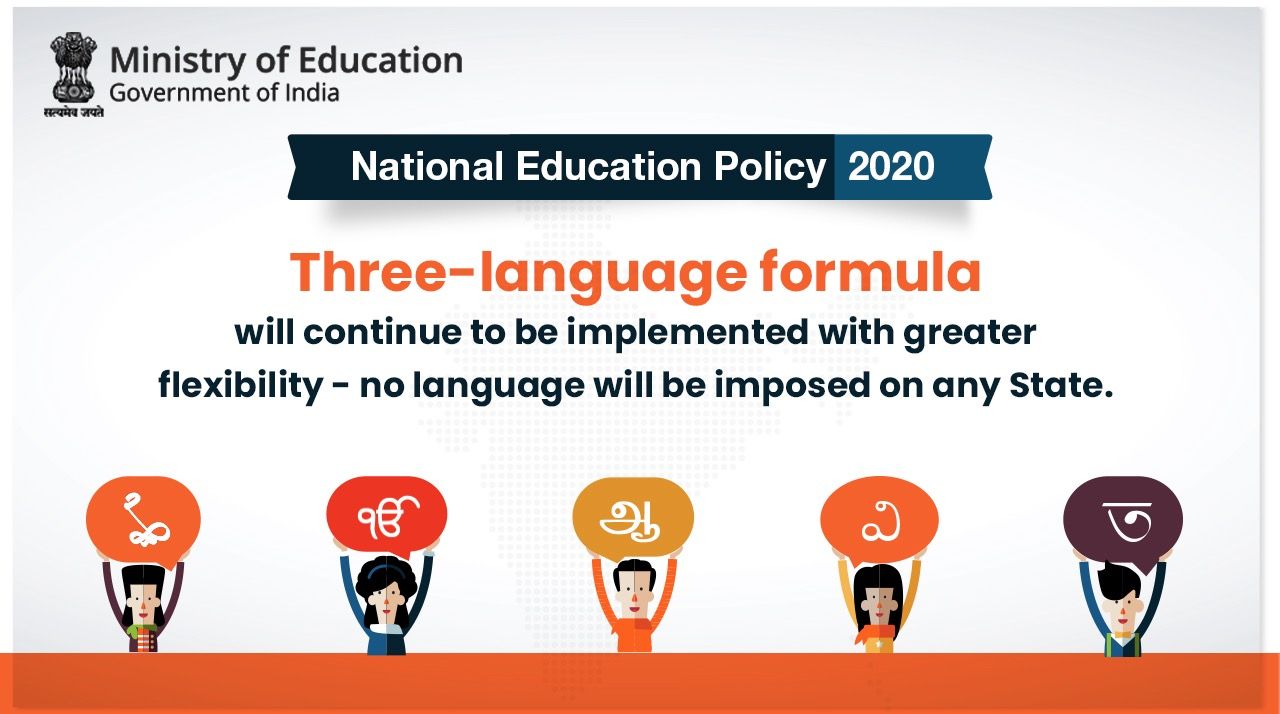Fulfilling Student Expectations in a Democratic Manner: NEP 2020

The Importance of Learning Three Languages
Language is the welcoming window to any culture. To learn a language is to be introduced to a new culture, a new set of traditions, a new network of people. To preserve a language is to preserve this culture, this tradition and this network of people. Bharata is a unique nation that has tens of scripts and hundreds of spoken languages. This makes our nation so vibrant, so colourful and so interesting even for ourselves.
Why is it important for us to have the option to learn three languages? For the very first time, as the New Education Policy was framed, inputs and suggestions from people all over the country were invited. The panel took several months to go through these suggestions, sort them into categories, discuss them and decide on the best option keeping in mind the well-being of the students and, eventually, of the society and the nation. Of the suggestions considered, the ones that dealt with the ground realities were given greater weightage by the panel of educationists.
When it came to learning languages, these were the vital details:
· Learning in one’s native language helps better assimilation of knowledge and boosts the confidence of the learner. The most practical approach to this is to offer the regional language as the medium of education compulsorily for the Primary Stage and, if possible, even at higher levels.
· There are students spread out in all regions whose native language is not the regional language. They are either from another part of the country OR their language is spoken by a minority number of people in the state. In such cases, it is important for these languages to be provided.
· For the students who belong to other states, being able to learn in the local language while also being able to learn their own native language is a great way to assimilate into both cultures seamlessly.
· For those who belong to minority language communities, this is a wonderful opportunity to obtain a boost for their own language which can now be learnt and propagated to the younger generations.
· At present many languages are living as mere spoken languages without being given the opportunity to be studied in schools. Some of these languages are endangered and some are headed towards extinction. For example, the mother tongues of the aborigines in all the states are rarely given the opportunity to study in schools, and all the cultures, wisdom and uniqueness of these languages will disappear if these languages become extinct. Even the uniqueness and pride of the people who speak this language will be destroyed with these languages. We can provide those languages through the trilingual program which would provide a wonderful opportunity to avoid this.
· For the students whose native language is the primary language of the state, learning a language that is spoken by the minorities in their region is an eye-opener to their culture, their literature and their traditions. It provides more opportunity for understanding, assimilation and integration between the communities.
· It has been scientifically proven that a person who studies several languages tends to gain a higher command over one’s own native language.
· In case the region has not a significant number of minorities, then it makes sense for the students to learn Sanskrit or any other Bharatiya language that may be offered by the school as second language. This provides an opportunity to learn and appreciate the great cultures of the land to which we all belong. Knowing more languages of our grand nation will impart greater pride and sense of belonging to this ancient and culturally dynamic land.
· Of course, in the present global scenario, learning English (or another foreign language such as Arabic, Japanese, Spanish etc.) may help in providing some options to advance one’s career. This can be the third language that the student learns.
How must the languages be taught?
The option of selecting the second language to be offered by the school must be made democratic.
Each school would automatically be using the majority spoken language of the state as the medium of education, which would also be the first language. The school must provide the option for students to request for some specific language(s) to be provided as second language at school. If there is a minimum number or a minimum percentage of students asking for a specific language, then it must be made available as an option with dedicated teachers to impart this knowledge.
If a very small number of students ask for some language to be taught, then a part-time teacher may be made available. As long as the teacher is available in the locality that the school is situated, learning a Bharatiya language of the student’s choice must not be a constraint.
FIRST language
The first language, which is taught from pre-school stage through the Primary Years and, maybe, beyond, must be taught with a lot of emphasis on good, accurate pronunciation, usage of the right vocabulary, reformation of spoken styles to make it more respectful, insightful and deep. While the focus of pre-schools would be on listening and speaking skills, there must be sufficient reading, recitation and storytelling at the lower primary levels. By this stage, pronunciation of the child sets in to a great extent. Well pronounced respect-filled language with the usage of the right vocabulary carried forward the power of vibrations of the language.

SECOND AND THIRD languages
The second language may be offered at two levels: Standard and Higher.
At the Standard level, focus may remain primarily on listening and speaking with just the basic reading and writing. This may be taught gradually over a period of five or six years, starting at the upper primary level.
At the Higher level, the student may opt to learn more in the language with more of grammar and literature and more in-depth study. The number of years of study for these students may also be increased.
The third language (since this would tend to be primarily English in most parts of the country) may be taught to the extent that the student is comfortable to comprehend, speak, read and write well. The emphasis must heavily be on effective and practical communication skills. Higher grammar and literature may be de-emphasised. English learning may begin at lower primary with listening and speaking and may continue gradually until middle school.
The aim of the policy is to enable students learn three languages in schools by democratically accepting students' language requests and provide the possibility for them to study them. Schools, State Governments and Ministries of Education must strongly register that they have no role in deciding what second language must be offered and, understanding that the intent of the New Education Policy is for our students to appreciate and enjoy the great linguistic and cultural variety of our nation, must take on the responsibility to offer any Bharatiya language that is being requested for without any kind of bias.
Jai Hind!
References:
8 Endangered Languages of India Heading Towards Extinction (procaffenation.com)
Endangered languages in Karnataka rising | Bengaluru News - Times of India (indiatimes.com)

